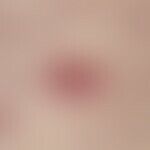Synonym(s)
DefinitionThis section has been translated automatically.
Initial infection of non-immune individuals with the varicella zoster virus. The infection leaves lifelong immunity. Endogenous reinfection leads to the clinical picture of zoster.
PathogenThis section has been translated automatically.
You might also be interested in
Occurrence/EpidemiologyThis section has been translated automatically.
The number of cases of chickenpox (compulsory reporting since 2013 !)
is estimated at 500,000 per year for Germany (before the introduction of vaccination). In total, about 75% of children under the age of 15 fall ill, including about 310,000 (41.5%) aged 0 to 5 years, about 320,000 (42.4%) aged 6 to 12 years and about 65,000 (8.8%) aged 12 to 15 years. The incidence of severe courses in hospitalized children < 16 years is 0.8/100,000 children.
In the age group of 10 to 11 years the rate of infection is 94%. In adolescents and adults up to 40 years of age there are still immunity gaps of about 3 to 4%.
According to international studies, the mortality rate of varicella in immunocompetents is between 0.03 and 0.05 per 100,000 person-years. The actual number of varicella-related deaths in Germany is 20-40 deaths per year (approx. 0.03/100,000 person/year). For adults, the number of deaths is given as 17-30/100,000. In children with leukaemia, the mortality rate is about 10%. Children with bronchial asthma and treatment with corticosteroids are also expected to have a complicated course.
Diaplacental transmission: Transmission of the virus via the placenta is rare, but can lead to congenital infection in 1-2% of cases in pregnant women, provided the disease occurred between the 5th and 24th week of pregnancy.
EtiopathogenesisThis section has been translated automatically.
Transmission of the virus from a varicella or zoster patient by droplet or smear infection, especially by contact with saliva or fluid contents of the vesicles as well as sneezing or coughing. After infection and replication in the epithelium of the respiratory tract (less frequently in the conjunctiva), the first viraemic phase and further replication in the lymphatic system occur.
ManifestationThis section has been translated automatically.
Mainly occurring in childhood (2/3 of all cases in the 5th to 9th year of life); rarely in adults (Varicellae adultorum); very rarely 2nd occurrence of varicella as a reinfection in adults.
LocalizationThis section has been translated automatically.
Infestation in cranio-caudal direction. First scalp (often infestation of the hairy scalp!) and oral mucosa (infestation almost obligatory; note: in case of v. a. varicella always inspect the oral mucosa!); then trunk and extremities. Palms and soles are usually left out.
Clinical featuresThis section has been translated automatically.
95% of infections are clinically manifest. The incubation period is usually about 14 days (9-23 days). After a short prodromal stage, slight fever, distinct itching and exanthema are observed.
Integument: Gradual appearance of small red spots with rapid transition to papules and vesicles. The content of the vesicles, which is initially clear, becomes cloudy and forms firmly adhering crusts which fall off after 2-3 weeks without leaving scars. Polymorphic exanthema due to the simultaneous presence of different developmental phases of efflorescence(Heubner's star map). The number of bubbles varies from a few to several hundreds. Due to scratching effects and secondary infection, varioliform scars may remain. Hemorrhagic or bullous transformation possible.
Mucous membranes: Yellowish covered erosions surrounded by a red hem. At the oral mucosa the hard palate and the cheek mucous membranes are preferentially affected. Less frequently, conjunctiva, larynx or genital mucous membranes are affected.
In children, usually without complications and without accompanying symptoms, rarely lymph node swelling.
In adults, usually a severe course with pronounced general symptoms, feeling ill, fever, headache, joint pain and swelling of the lymph nodes.
DiagnosticsThis section has been translated automatically.
Nucleic acid detection of varicella zoster virus from vesicle contents (PCR)
If necessary, serology: VZV IgG detection in serum, in particular also as a check of the vaccination status/vaccination success.
Differentiation of primary infection (varicella) from endogenous recurrence (herpes zoster) also possible.
HistologyThis section has been translated automatically.
Differential diagnosisThis section has been translated automatically.
Zoster generalisatus: Elderly persons, segmental infestation pattern is always still detectable
Eczema herpeticatum: previously known atopic dermatitis, also in children highly febrile course
Prurigo simplex acuta infantum: urticarial papules, sometimes with vesicles, episodic, violently itching, no feeling of illness.
Prurigo simplex subacuta: long-term chronicity, scratched chronic papules.
Other viral exanthema (Coxsackie and ECHO viruses; EBV). Serology.
Complication(s)This section has been translated automatically.
Impetiginisation, skin gangrene, bronchitis, varicella pneumonia (20-30/10,000 adults), aseptic meningoencephalitis, acute cerebellar ataxia (2-3/10,000 children). Otitis media, nephritis, arthritis, myocarditis, purpura fulminans, Reye's syndrome, bacterial sepsis originating from the skin (2-3/10,000 children), organ infestation, especially in immunocompromised patients.
Infection during pregnancy: incidence: 1-3/1000 pregnancies. Diaplacental infection about 25%. Congenital Varicella syndrome occurs in 1-12% of all infected persons.
External therapyThis section has been translated automatically.
Children: Mainly external treatment.
General: Trim fingernails, gloves overnight if necessary.
Vesicle stage: Only local drying measures, e.g. dry brushing with Lotio alba or synthetic tanning agents (e.g. Tannolact Lotio, Tannosynt), zinc sulphate hydrogel, full baths with potassium permanganate additive(light pink) or quinolinol (e.g. Chinosol 1:1000 or R042 ) as bath additive or rubs with diluted vinegar water. For itching 2-5% polidocanol in lotio alba or as gel R197 or milk(polidocanol milk) .
In superinfection: Clioquinol cream(Linola-Sept) or lotio alba with 0.5-2% clioquinol added R050.
Crust stage: Initially antiseptic ointments e.g. Clioquinol cream R049, later emollient ointments promoting healing e.g. Dexpanthenol ointment or cream (e.g. Bepanthen).
Notice. Antibiotic-containing topical preparations should be used with caution in cases of extensive spread (germ selection! risk of sensitisation! systemic side effects!).
In case of mucosal involvement: mouth rinses (e.g. Dexpanthenol Lsg. R066 ), Kamillosan Lsg., or Tormentill astringent R255, if necessary anaesthetic and/or antibiotic added solutions or mouth gels or mouth pastes (e.g. Dolo-Dobendan solution, Acoin solution, Parodontal mouth ointment, Hexoral Lsg., Kamistad gel).
In case of fever: bed rest, conservative antipyretic measures(calf compresses, icepacks in the groin), if necessary antipyretic medication (e.g. paracetamol 250 mg supp.). Ensure sufficient fluid intake.
No acetylsalicylic acid, Cave!Reye's syndrome.
For itching 2-5% polidocanol in lotio alba or as gel R197 or milk (polidocanol milk).
Adults:
- Vesicle stage: drying disinfectant polidocanol-zinc oxide shake mixture 3-10% R200. In superinfection, antiseptic additives such as clioquinol 2-5% or zinc sulfate R298. Alternatively brush idoxuridine solution (e.g. Zostrum) 4 times/day on infected skin. Caution. Do not use idoxuridine solution for longer than 4 days.
- Crust stage: Initially antiseptic ointments e.g. 2-5% Clioquinol cream R049, later emollient, healing-promoting ointments (e.g. Dexpanthenol ointment).
Internal therapyThis section has been translated automatically.
- Children: Antihistamines p.o. such as dimetindene (e.g., Fenistil trp., 10-15 trp. p.o. 3 times/day), doxylamine (e.g., Mereprine) 1-3 times/day 1-2 tsp. p.o., or cetirizine (e.g., Zyrtec trp./juice, 2-3 times 1/2-1 tsp./day).
- Immunosuppressed children: Aciclovir 500 mg/m2 KO 3 times/day every 8 hr for 5 days i.v.
- Adults: Aciclovir 5 mg/kg bw as a short infusion 3 times/day every 8 hrs for 5-7 days. Caveat. Blood count control, as well as control of liver and kidney values, are required.
- Alternative: Aciclovir 800mg p.o. 5 times/day for 5-10 days.
- Alternative: Valaciclovir 1000mg p.o. 3 times/day for 7 days.
- Alternative: brivudine 1 time/day 125 mg/day p.o. for 7 days.
- Immunocompromised adults: aciclovir 3 times/day 15 mg/kg bw as a short infusion for 5-10 days. In proven HIV infection, dosage depending on the number of CD4-positive cells.
- Pregnancy: Seronegative pregnant women may develop severe courses (especially in the 3rd trimester) with a 10% chance of developing varicella pneumonia. Therapy with aciclovir 3 times/day 10-15 mg/kg bw i.v. (for aciclovir and valciclovir frequent malformations have not been proven so far; for forensic reasons it is recommended to sign an "informed consent" form).
ProphylaxisThis section has been translated automatically.
- Since August 2004, varicella vaccination (active immunization) has been recommended by the STIKO (Standing Commission on Vaccination) for all children and adolescents. Vaccination should preferably be carried out at the age of 11-14 months, but can also be carried out at any time thereafter. Still unvaccinated 9- to 17-year-olds without a history of chickenpox should be vaccinated, as the disease is associated with a higher complication rate in them. In addition, vaccination is indicated in seronegative women of childbearing potential, seronegative patients on immunosuppressive therapy, patients with leukemia, patients with severe atopic eczema, and seronegative healthcare workers.
- In unvaccinated persons with a negative history of chickenpox and contact with ill persons, postexposure vaccination should be considered within 5 days of contact or within 3 days of the onset of exanthema.
- Prophylaxis after contact with a person with varicella using passive immunization (varicella-zoster immunoglobulin) is recommended within 96 hours of contact for persons at increased risk for complications. It can prevent or significantly attenuate the onset of disease. This population includes unvaccinated pregnant women with no history of chickenpox, immunocompromised patients with unknown immunity, and newborns whose mothers had varicella 5 days before to 2 days after delivery.
- Active immunization (live vaccine): Varilrix® 0.5 ml s.c. e.g. in HIV-positive patients without varicella AK and with negative varicella history. AK control and if more than 200 CD4 cells/µl, or after consultation with HIV specialist, repeat after 3 months if necessary if vaccination protection is insufficient. Alternative preparation: Varivax. Caution! Contraindication: Pregnancy, massive immunosuppression, previous VZV infection.
- Passive immunization with Varicella-Zoster-Hyperimmunoglobulin (e.g. Varitect®, Varicellon®), at the latest 96 hours after exposure. Varitect®: 1 ml/kg i.v. once or Varicellon®: at least 0.2 ml/kg bw i.m.
TablesThis section has been translated automatically.
Systemic antiviral therapy in immunocompromised patients
Immune status |
Active substance |
Dosage |
CD4 cells > 200/µl |
Aciclovir |
5 times/day 12 mg/kg bw p.o. = 5 times/day 1 tbl. 800mg |
Famciclovir |
3 times/day 250 mg p.o. = 3 times/day 1 tbl. p.o. |
|
Valaciclovir |
3 times/day 1000 mg p.o. = 3 times/day 2 tbl. à 500 mg p.o. |
|
Brivudine (Zostex) Cave: (not approved in immunocompromised patients). |
1 time/day 125 mg p.o. for 7 days; Cave: do not use in combination with 5-fluorouracil! |
|
| ||
CD4 cells < 200/µl |
Aciclovir |
3 times/day 10 mg/kg bw i.v. every 8 hours for 10 days. |
Foscarnet (foscavir) In case of aciclovir resistance (use only if renal function is intact). |
40 mg/kg bw i.v. 3 times/day = 2400 mg i.v. 3 times/day, each infused on 100 ml glucose 5% diluted to 500 ml over 1 hour, duration unlimited. |
|
Note(s)This section has been translated automatically.
Since March 29, 2013, there has been a nationwide, name-based obligation for physicians and laboratories to report chickenpox if the disease is suspected and/or detected, in accordance with the Infection Protection Act.
LiteratureThis section has been translated automatically.
- Andrei G et al (1995) Comparative activity of selected antiviral compounds against clinically isolated varicella-zoster virus. J Clin Microbiol Infect Dis 14: 318-329.
- Banz K et al (2003) The cost-effectiveness of routine childhood varicella vaccination in Germany. Vaccine 21: 1256-1267
- Fiddian AP (1995) Valaciclovir - an improved treatment for individuals with HIV and Aids. Antiviral Chemistry & Chemotherapy 6: 51-53
- Galil K et al (2002) Outbreak of varicella at a day-care center despite vaccination. N Engl J Med 347: 1909-1915.
- Gerard L (1995) Pharmacology and clinical use of foscarnet. Int J Antimicrobial Agents 5: 209-217.
- Gershon A (2004) Varicella-zoster virus. In: Feigin RD, Cherry JD, Demmler GJ, Kaplan SL (eds): Textbook of Pediatric Infectious Diseases. Saunders, Philadelphia, p. 1962
- Gross G et al (2003) Herpes zoster guideline of the German Dermatology Society (DDG). J Clin Virol 26: 277-289
- Kaplan JE, Masur H et al (2002) Guidelines for preventing opportunistic infections among HIV-infected persons-2002. Recommendations of the U.S. Public Health Service and the Infectious Diseases Society of America. MMWR Recomm Rep 51: 1-52.
- Kempf W, Lautenschlager S (2001) Infections with varicella zoster virus. Dermatologist 52: 359-376
- Mazzella M et al (2003) Severe hydrocephalus associated with congenital varicella syndrome. CMAJ 168: 561-563
- Mohsen AH et al (2003) Varicella pneumonia in adults. Eur Respir J 21: 886-891.
- Müllegger RR et al (2010) Skin infections in pregnancy. Dermatologist 61: 2066-2069
- Rappersberger K (1999) Infections with herpes simplex and varicella zoster virus in pregnancy: clinical manifestations in mother, fetus and newborn--therapeutic options. Dermatologist 50: 706-714
- Snoeck R et al (1994) Chemotherapy of varicella zoster virus infections. Int J Antimicrobial Agents 4: 211-226.
- Swingler G (2003) Chickenpox. Clin Evid 9: 755-762.
- Wutzler P et al (2002) Seroprevalence of varicella-zoster virus in the German population. Vaccine 20: 121-124
- Fromme JE et al (2022) Viral exanthems in children. Dermatologist. 73:452-460
Incoming links (44)
active vaccination; Aphthoid pospischill-feyrter; Bubbles; Chickenpox; Chicken pox; Cortisone acetate; Dexpanthenol solution 5% (nrf 7.3.); Enanthem; Fleabite; Giant cell arteritis; ... Show allOutgoing links (46)
Acetylsalicylic acid; Aciclovir; Antihistamines, systemic; Atopic dermatitis (overview); Basal cell; Brivudin; Bubbles; Cetirizine; Clioquinol; Clioquinol cream 0.5-2% (o/w); ... Show allDisclaimer
Please ask your physician for a reliable diagnosis. This website is only meant as a reference.






























